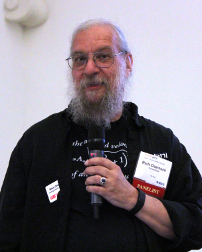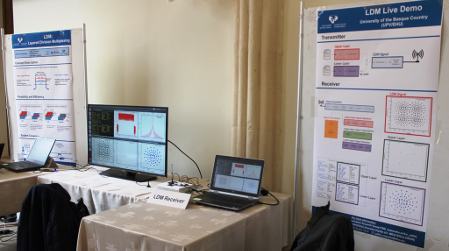LDM Transmission Hot Topic at BMSB

This 800-year-old former Ghent monastery was the site of the 10th annual BMSB conference.
GHENT, BELGIUM—A former 13th century Dominican monastery in this medieval city recently served as the backdrop for the dissemination of information that was anything but historical or “old world.” The event was the 10th annual Broadband Multimedia Systems and Broadcasting conference, with video experts from around the world convening here to present and exchange ideas on the latest developments in television.
The June 17-19 symposium drew some 150 television scientists and engineers and featured presentations covering everything from the embodiment of MIMO technology in UHD broadcasting to a proposal for enhancing viewing experiences through the resurrection of “smell-o-vision.” However, a relatively new transmission technology—layered division multiplex or “LDM,” which will be incorporated in to the U.S. ATSC 3.0 television standard—appeared to garner a great deal of interest among conference participants. It was the subject of at least 10 papers and was referenced directly or indirectly in a number of other presentations.
LDM SEEN AS POWERFUL TOOL IN NEXT-GEN TV
LDM seems destined to play a big role in future television systems as it addresses content delivery to a variety of viewing devices, according to Richard Chernock, BMSB session chair, chief science officer at Triveni Digital and member of the ATSC 3.0 standards development committee.

Richard Chernock
“Broadcasters are interested in the different broadcast delivery models provided by ATSC 3.0, which range from robust transmission to moving or indoor receivers up to very efficient delivery of UHDTV to rooftop antennas,” said Chernock. “One of the new tools available is layer division multiplexing, which allows simultaneous transmission of both modes through the use of power multiplexing. LDM (in addition to TDM [time domain multiplexing]) will provide broadcasters the capability to... pursue the mixture of business models that they desire.”
LDM, in simplest terms, lets broadcasters pack more digital information within their allotted channel slots. The technology allows stacking of physical layer data streams with varying power levels, modulation schemes and data coding, thus offering a great deal of flexibility and robustness in delivering video to fixed and mobile receive sites. Such architecture ensures that all available transmission bandwidth is fully utilized and can provide a boost of three to six dB of signal-to-noise improvement—something that can make the difference between a great picture or no reception at all for television receiving devices situated in challenging receive site locations.
HOW IT ALL STARTED
Yiyan Wu, another BMSB session chair and also principle research scientist at the Communications Research Centre Canada is credited with being the originator of the LDM concept and was asked how his idea came about.
“About five years ago I was driving my 13-year-old daughter Cindy to a school activity and there was a brand-new double-decker bus in front of me,” said Wu. “I said ‘I hate those double-deckers; they totally block my view. I cannot even see the traffic lights. I do not know what they are good for.’”
Wu said that his daughter responded that such vehicles had the same footprint as a regular bus, but could carry twice the passenger load—something she had heard mentioned a few days before in a radio broadcast.
“That made me start thinking,” said Wu. “If we want to increase the capacity [in connection with DTV transmission], we [could] pile up the ‘bits’ vertically in multiple layers.”
NOT JUST FOR ATSC 3.0

Yiyan Wu When asked about the applicability of LDM technology in connection with advanced digital television transmission systems other than ATSC 3.0, Wu responded:
“A good technology speaks for itself…the NHK Sciences and Technology Research Laboratories (NHK-STRL) of Japan and the National Engineering Research Center on Digital TV (NERC-DTV) of China are strong supporters of the LDM technologies. They are major standard-setting organizations in their countries.”
Wu also cited research work being done at the Mackenzie University of Brazil on applying LDM to the ISDB-T digital television systems adopted in Brazil and Japan.
“I would say that LDM has a good chance to make the next generation DTV standards in other parts of the world,” Wu said.
As mentioned by Wu, other research organizations have been quick to pick up on the LDM concept. One of these was Spain’s University of the Basque Country, which was well represented at the BMSB event.
One of the conference participants was Pablo Angueira, an associate professor in the department of electronics and telecommunications at the University. He spoke about the school’s involvement with LDM technology.
“The first [iteration] was called cloud transmission; however, this was not exactly the concept of LDM. But based on that, a cooperative project was initiated between CRC Canada, ETRI [Electronics and Telecommunications Research Institute] in Korea, and our university. We developed the final LDM concept that will be part of the ATSC 3.0 standard.”
LDM ON DISPLAY
Angueira and his associates brought a working demonstration model of LDM technology to the conference that operated throughout the three-day event. He explained that this “breadboard” version was really the initial realization of the new transmission technology.
“The first version of this development was shown one year ago, so it’s fairly new,” said Angueira. “In fact the software-defined radio setup being demonstrated here was the first LDM prototype. ETRI later developed its own full-power real-time transmitter and receiver.

Spain’s University of the Basque Country provided this working model of an LDM transmission system.
“We have two power modules for transmitting and receiving, but they are only performing the IF part of the transmission system. The baseband part is all software—software defined radio. We are transmitting two layers, with the upper layer the robust one with QPSK and the lower layer is a non-uniform carrying a non-uniform constellation—64 QAM. These are the constellations now accepted in ATSC 2.0. The upper one carries 4.1 mbps and the lower one carries 19 mbps, so in total we’re running 23 or 24 mbps. The use case for this is sending content on the upper layer for mobile receivers and portable receivers. The lower layer would be for fixed reception with a rooftop antenna, with results similar to what you would expect from ATSC 1.0 or 2.0.
Angueira stated that equipment shown would be going to Shanghai in October for testing there in connection with the ATSC 3.0 standards process.
Television scientists and engineers from more than 25 nations participated in the Ghent IEEE BMSB conference, which serves as a forum for the presentation and exchange of ideas in the fields of multimedia media broadcasting, telecommunications, data networking technologies and consumer electronics. The 2016 conference will be held June 1-3 in Nara, Japan.
Get the TV Tech Newsletter
The professional video industry's #1 source for news, trends and product and tech information. Sign up below.
